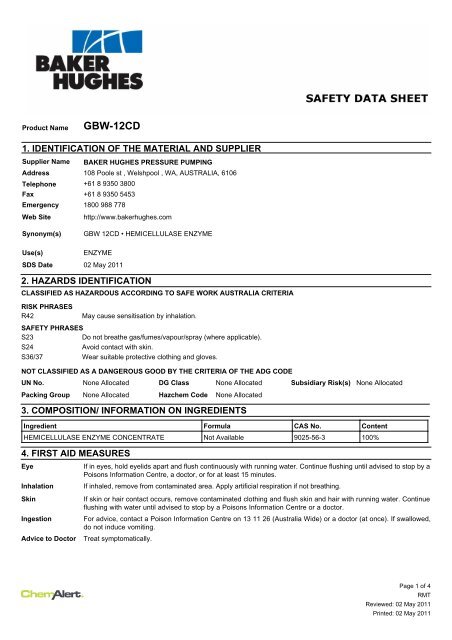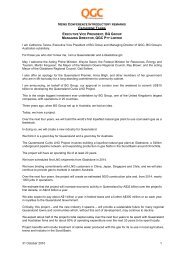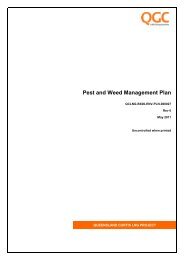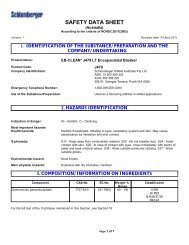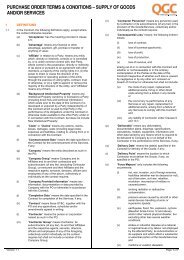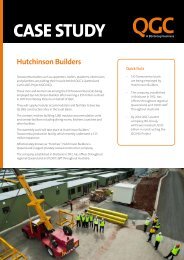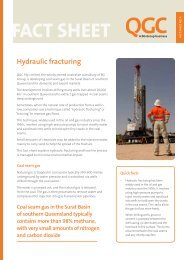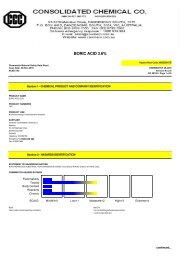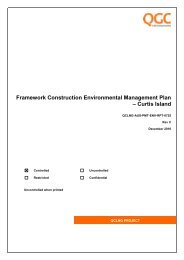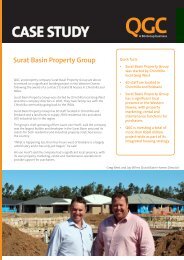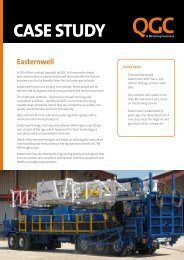BJ Services MSDS - GBW-12CD - Santos
BJ Services MSDS - GBW-12CD - Santos
BJ Services MSDS - GBW-12CD - Santos
Create successful ePaper yourself
Turn your PDF publications into a flip-book with our unique Google optimized e-Paper software.
Product Name<br />
<strong>GBW</strong>-<strong>12CD</strong><br />
1. IDENTIFICATION OF THE MATERIAL AND SUPPLIER<br />
Supplier Name<br />
Address<br />
Telephone<br />
Fax<br />
Emergency<br />
Web Site<br />
Synonym(s)<br />
BAKER HUGHES PRESSURE PUMPING<br />
108 Poole st , Welshpool , WA, AUSTRALIA, 6106<br />
+61 8 9350 3800<br />
+61 8 9350 5453<br />
1800 988 778<br />
http://www.bakerhughes.com<br />
<strong>GBW</strong> <strong>12CD</strong> • HEMICELLULASE ENZYME<br />
Use(s)<br />
SDS Date<br />
ENZYME<br />
02 May 2011<br />
2. HAZARDS IDENTIFICATION<br />
CLASSIFIED AS HAZARDOUS ACCORDING TO SAFE WORK AUSTRALIA CRITERIA<br />
RISK PHRASES<br />
R42<br />
May cause sensitisation by inhalation.<br />
SAFETY PHRASES<br />
S23<br />
Do not breathe gas/fumes/vapour/spray (where applicable).<br />
S24<br />
Avoid contact with skin.<br />
S36/37 Wear suitable protective clothing and gloves.<br />
NOT CLASSIFIED AS A DANGEROUS GOOD BY THE CRITERIA OF THE ADG CODE<br />
UN No.<br />
None Allocated DG Class None Allocated Subsidiary Risk(s) None Allocated<br />
Packing Group<br />
None Allocated<br />
Hazchem Code<br />
None Allocated<br />
3. COMPOSITION/ INFORMATION ON INGREDIENTS<br />
Ingredient Formula CAS No. Content<br />
HEMICELLULASE ENZYME CONCENTRATE Not Available 9025-56-3 100%<br />
4. FIRST AID MEASURES<br />
Eye<br />
Inhalation<br />
Skin<br />
Ingestion<br />
Advice to Doctor<br />
If in eyes, hold eyelids apart and flush continuously with running water. Continue flushing until advised to stop by a<br />
Poisons Information Centre, a doctor, or for at least 15 minutes.<br />
If inhaled, remove from contaminated area. Apply artificial respiration if not breathing.<br />
If skin or hair contact occurs, remove contaminated clothing and flush skin and hair with running water. Continue<br />
flushing with water until advised to stop by a Poisons Information Centre or a doctor.<br />
For advice, contact a Poison Information Centre on 13 11 26 (Australia Wide) or a doctor (at once). If swallowed,<br />
do not induce vomiting.<br />
Treat symptomatically.<br />
Page 1 of 4<br />
RMT<br />
Reviewed: 02 May 2011<br />
Printed: 02 May 2011
Product Name<br />
<strong>GBW</strong>-<strong>12CD</strong><br />
5. FIRE FIGHTING MEASURES<br />
Flammability<br />
Fire and<br />
Explosion<br />
Extinguishing<br />
Hazchem Code<br />
Non flammable. May evolve toxic gases (carbon oxides, hydrocarbons) when heated to decomposition. Product<br />
may burn in fire situation after water has evaporated from the mixture.<br />
Treat as per requirements for Surrounding Fires: Evacuate area and contact emergency services. Remain upwind<br />
and notify those downwind of hazard. Wear full protective equipment including Self Contained Breathing<br />
Apparatus (SCBA) when combating fire. Use waterfog to cool intact containers and nearby storage areas.<br />
Prevent contamination of drains or waterways.<br />
None Allocated<br />
6. ACCIDENTAL RELEASE MEASURES<br />
Spillage<br />
Contact emergency services where appropriate. Use personal protective equipment. Clear area of all unprotected<br />
personnel. Ventilate area where possible. Contain spillage, then cover / absorb spill with non-combustible<br />
absorbent material (vermiculite, sand, or similar), collect and place in suitable containers for disposal. CAUTION:<br />
Spill site may be slippery.<br />
7. STORAGE AND HANDLING<br />
Storage<br />
Handling<br />
Store in a cool, dry, well ventilated area, removed from oxidising agents, acids and foodstuffs. Ensure containers<br />
are adequately labelled.<br />
Before use carefully read the product label. Use of safe work practices are recommended to avoid eye or skin<br />
contact and inhalation. Observe good personal hygiene, including washing hands before eating. Prohibit eating,<br />
drinking and smoking in contaminated areas.<br />
8. EXPOSURE CONTROLS/ PERSONAL PROTECTION<br />
Exposure Stds<br />
No exposure standard(s) allocated.<br />
Biological Limits<br />
Engineering<br />
Controls<br />
PPE<br />
No biological limit allocated.<br />
Avoid inhalation. Use in well ventilated areas.<br />
Wear splash-proof goggles and rubber or PVC gloves. If dust is generated (eg. if product is allowed to dry out),<br />
wear a P2 (Particulate) respirator. When using large quantities or where heavy contamination is likely, wear:<br />
coveralls. Where an inhalation risk exists, wear: a Type A (Organic vapour) respirator.<br />
9. PHYSICAL AND CHEMICAL PROPERTIES<br />
Appearance BROWN LIQUID Solubility (water) SOLUBLE<br />
Odour SWEET ORGANIC ODOUR Specific Gravity 1.2<br />
pH 3.5 to 5.0 % Volatiles NOT AVAILABLE<br />
Vapour Pressure NOT AVAILABLE Flammability NON FLAMMABLE<br />
Vapour Density NOT AVAILABLE Flash Point NOT RELEVANT<br />
Boiling Point NOT AVAILABLE Upper Explosion Limit NOT RELEVANT<br />
Melting Point 0°C Lower Explosion Limit NOT RELEVANT<br />
Evaporation Rate<br />
NOT AVAILABLE<br />
Autoignition Temperature NOT AVAILABLE Decomposition Temperature NOT AVAILABLE<br />
Partition Coefficient NOT AVAILABLE Viscosity NOT AVAILABLE<br />
Page 2 of 4<br />
RMT<br />
Reviewed: 02 May 2011<br />
Printed: 02 May 2011
Product Name<br />
<strong>GBW</strong>-<strong>12CD</strong><br />
10. STABILITY AND REACTIVITY<br />
Chemical Stability<br />
Conditions to Avoid<br />
Material to Avoid<br />
Hazardous<br />
Decomposition<br />
Products<br />
Hazardous Reactions<br />
Health Hazard<br />
Summary<br />
Eye<br />
Inhalation<br />
Skin<br />
Ingestion<br />
Toxicity Data<br />
Stable under recommended conditions of storage.<br />
Avoid heat, sparks, open flames and other ignition sources.<br />
Incompatible with oxidising agents and acids (eg. nitric acid).<br />
May evolve toxic gases (carbon oxides, hydrocarbons) when heated to decomposition.<br />
Polymerization is not expected to occur.<br />
11. TOXICOLOGICAL INFORMATION<br />
Environment<br />
Low to moderate toxicity - irritant. This product has the potential to cause adverse health effects with over<br />
exposure. Use safe work practices to avoid eye or skin contact and inhalation. May cause sensitisation by<br />
inhalation in susceptible individuals. Those individuals with pre-existing respiratory impairment or disease are<br />
advised to avoid exposure.<br />
Irritant. Contact may result in irritation, lacrimation, pain and redness.<br />
Irritant. Over exposure may result in irritation of the nose and throat, coughing, dizziness and headache. May<br />
cause sensitisation by inhalation in susceptible individuals. Those individuals with pre-existing respiratory<br />
impairment or disease are advised to avoid exposure.<br />
Irritant. Contact may result in irritation, redness, rash and dermatitis.<br />
Low to moderate toxicity. Ingestion may result in gastrointestinal irritation, nausea, vomiting, headache and<br />
diarrhoea.<br />
No LD50 data available for this product.<br />
12. ECOLOGICAL INFORMATION<br />
No known ecological damage is caused by this product.<br />
13. DISPOSAL CONSIDERATIONS<br />
Waste Disposal<br />
Legislation<br />
For small amounts absorb with sand, vermiculite or similar and dispose of to an approved landfill site. Contact the<br />
manufacturer for additional information if larger amounts are involved.<br />
Dispose of in accordance with relevant local legislation.<br />
14. TRANSPORT INFORMATION<br />
NOT CLASSIFIED AS A DANGEROUS GOOD BY THE CRITERIA OF THE ADG CODE<br />
Shipping Name<br />
UN No.<br />
Packing Group<br />
None Allocated<br />
None Allocated DG Class None Allocated Subsidiary Risk(s) None Allocated<br />
None Allocated Hazchem Code None Allocated<br />
15. REGULATORY INFORMATION<br />
Poison Schedule<br />
AICS<br />
16. OTHER INFORMATION<br />
Additional<br />
Information<br />
A poison schedule number has not been allocated to this product using the criteria in the Standard for the Uniform<br />
Scheduling of Drugs and Poisons (SUSDP).<br />
All chemicals listed on the Australian Inventory of Chemical Substances (AICS).<br />
National Industrial Chemicals Notification and Assessment (NICNAS) Registration number: 2475.<br />
WORKPLACE CONTROLS AND PRACTICES: Unless a less toxic chemical can be substituted for a hazardous<br />
substance, ENGINEERING CONTROLS are the most effective way of reducing exposure. The best protection is<br />
to enclose operations and/or provide local exhaust ventilation at the site of chemical release. Isolating operations<br />
can also reduce exposure. Using respirators or protective equipment is less effective than the controls mentioned<br />
above, but is sometimes necessary.<br />
RESPIRATORS: In general the use of respirators should be limited and engineering controls employed to avoid<br />
exposure. If respiratory equipment must be worn ensure correct respirator selection and training is undertaken.<br />
Remember that some respirators may be extremely uncomfortable when used for long periods. The use of air<br />
Page 3 of 4<br />
RMT<br />
Reviewed: 02 May 2011<br />
Printed: 02 May 2011
Product Name<br />
<strong>GBW</strong>-<strong>12CD</strong><br />
powered or air supplied respirators should be considered where prolonged or repeated use is necessary.<br />
ABBREVIATIONS:<br />
ACGIH - American Conference of Industrial Hygienists.<br />
ADG - Australian Dangerous Goods.<br />
BEI - Biological Exposure Indice(s).<br />
CAS# - Chemical Abstract Service number - used to uniquely identify chemical compounds.<br />
CNS - Central Nervous System.<br />
EC No - European Community Number.<br />
HSNO - Hazardous Substances and New Organisms.<br />
IARC - International Agency for Research on Cancer.<br />
mg/m³ - Milligrams per Cubic Metre.<br />
NOS - Not Otherwise Specified.<br />
pH - relates to hydrogen ion concentration using a scale of 0 (high acidic) to 14 (highly alkaline).<br />
ppm - Parts Per Million.<br />
RTECS - Registry of Toxic Effects of Chemical Substances.<br />
STEL - Short Term Exposure Limit.<br />
SWA - Safe Work Australia.<br />
TWA - Time Weighted Average.<br />
HEALTH EFFECTS FROM EXPOSURE:<br />
It should be noted that the effects from exposure to this product will depend on several factors including: frequency<br />
and duration of use; quantity used; effectiveness of control measures; protective equipment used and method of<br />
application. Given that it is impractical to prepare a Chem Alert report which would encompass all possible<br />
scenarios, it is anticipated that users will assess the risks and apply control methods where appropriate.<br />
PERSONAL PROTECTIVE EQUIPMENT GUIDELINES:<br />
The recommendation for protective equipment contained within this Chem Alert report is provided as a guide only.<br />
Factors such as method of application, working environment, quantity used, product concentration and the<br />
availability of engineering controls should be considered before final selection of personal protective equipment is<br />
made.<br />
Report Status<br />
This document has been compiled by RMT on behalf of the manufacturer of the product and serves as the<br />
manufacturer's Safety Data Sheet ('SDS').<br />
It is based on information concerning the product which has been provided to RMT by the manufacturer or<br />
obtained from third party sources and is believed to represent the current state of knowledge as to the appropriate<br />
safety and handling precautions for the product at the time of issue. Further clarification regarding any aspect of<br />
the product should be obtained directly from the manufacturer.<br />
While RMT has taken all due care to include accurate and up-to-date information in this SDS, it does not provide<br />
any warranty as to accuracy or completeness. As far as lawfully possible, RMT accepts no liability for any loss,<br />
injury or damage (including consequential loss) which may be suffered or incurred by any person as a<br />
consequence of their reliance on the information contained in this SDS.<br />
Prepared By<br />
Risk Management Technologies<br />
5 Ventnor Ave, West Perth<br />
Western Australia 6005<br />
Phone: +61 8 9322 1711<br />
Fax: +61 8 9322 1794<br />
Email: info@rmt.com.au<br />
Web: www.rmt.com.au<br />
SDS Date02 May 2011<br />
End of Report<br />
Page 4 of 4<br />
RMT<br />
Reviewed: 02 May 2011<br />
Printed: 02 May 2011


